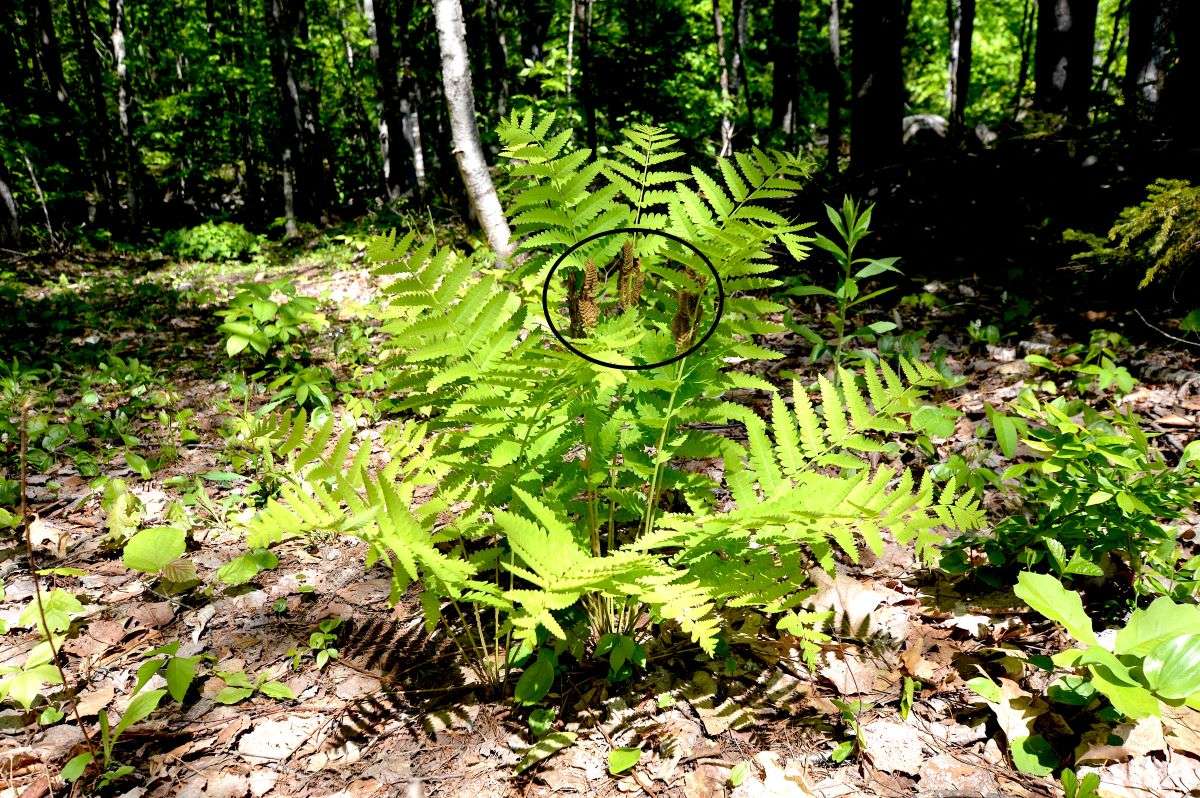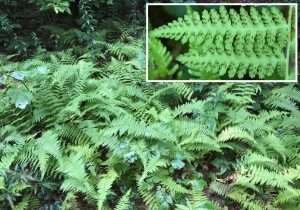Out in the Woods
- August 23rd 2024
- Out in the Woods

“Interruptions” along a fern’s blades can hold the fern’s spore-producing reproductive parts, or sori.
The Complex Reproductive Lives of Ferns

A colony of hay scented fern. The inset shows the fern’s sori, holding its reproductive spores.
Photo Credits: K. McKeon
By Kevin McKeon, Maine Master Naturalist
Various kinds of ferns grow along our wonderful trails. Some reveal their reproductive parts on their leaves. With others, you have to look a little closer.
Let’s start by describing the various parts of a fern. https://www.pinterest.com/pin/17310779797784835/ What we see are leaves, or fronds, which grow from an underground stem called a rhizome. Think of the rhizome as the twig or branch of the plant. The parts of the frond are as follows: The fern’s stem, or petiole, is called the stipe; the main vein of the leaf is the rachis; all the leafy parts (leaflets) attached to the rachis are collectively called the blade. Each individual leafy part (leaflet) attached to the rachis is a pinna; and the pinna on some lacy ferns are subdivided into even smaller, leaf lobe-like parts called pinnules. So instead of leaf, leaflet, and leaf lobe, in “fern talk” it’s once, twice, and thrice divided pinnae.
The reproductive parts of ferns are called sori, and they nurture wind-blown spores for reproduction. Spores have various types of “wings” that aid in spreading their genes via the winds, meaning a new spore could and does catch the trade winds — even lofting up to the jet stream — landing on soil at the wind’s pleasure, enabling procreation not only within a landscape but around the Earth, via the Earth’s wind rivers. Wherever the spores land and find fertile ground in a suitable habitat, a fern will grow. Take a deeper dive into sori here.
The spore is non-sexual, but will grow into a gametophyte, anchored to the soil or rock via rhizoids. This is the sexual phase of our fern, producing both male and female organs. Under moist conditions like dew drops, rain, or tropical moisture, the male swims to the female and they combine in fertilization. Cell reproduction ensues, and our fern grows from the gametophyte, developing into our mature fern. This explains why a greater diversity of fern species is found in wetlands and in the tropics.
Circinate vernation describes how a fern’s frond emerges from its crozier — better known to us as a fiddlehead. (The prized, tasty fiddleheads are the croziers of the ostrich fern.). The frond is tightly curled, protected within the fiddlehead. As it emerges, it begins to photosynthesize, feeding itself and growing to full size. Watch the emerging fiddlehead here.
Almost all ferns are perennial, some living to over 40 years in the tropics. According to Arthur Haines, research botanist for the Native Plant Trust, there are 61 species of ferns in Maine. Others estimate about 10,500 named species worldwide, plus another 3,000 to 5,000 species yet to be discovered. Fern size range from the ⅜” Azolla water fern — which forms large colonies on the water’s surface to appear algae-like — to the over 65-foot Norfolk tree fern of Norfolk Island near New Zealand.






